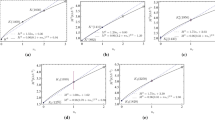Summary
The observed masses of the vector and tensor meson notets are incompatible with the constraints of duality and the absence of exotic resonance, unless one invokes a very peculiar type ofSU 3 breaking in coupling strengths. Further, the masses of the pseudoscalar mesons are incompatible with these hypotheses irrespective of anySU 3 considerations. Thus, in the absence of exotic resonances, the mesonic mass spectrum seems to suggest a strong breaking of duality even for meson-baryon scatterings.
Riassunto
Le masse osservate dei nonetti mesonici vettoriali e tensoriali sono incompatibili con le restrizioni di dualità e assenza di risonanza esotica, a meno che non si invochi un tipo molto particolare di rottura dellaSU 3 nelle intensità di accoppiamento. Inoltre le masse dei mesoni pseudoscalari sono incompatibili con queste ipotesi a prescindere da ogni considerazione dellaSU 3. Così, in assenza di risonanze esotiche, lo spettro di massa dei mesoni sembra suggerire una forte rottura della dualità anche per gli scattering mesonebarione.
Резюме
Наблюдаемые массы нонетов векторных и тензорных мезонов несовместимы с ограничениями дуальности и отсутствием экзотического резонанса, если только не прибегнуть к очень специфическому типу нарушенияSU 3 по константе связи. Кроме того, массы псевдоскалярных мезонов несовместимы с этими гипотезами, безотносительно к любымSU 3-рассмотрениям. Таким образом, при отсутствии экзотических резонансов спектр мезонных масс, по-видимому, предполагает сильное нарушение дуальности, даже для мезон-барионных рассеяний.
Similar content being viewed by others
References
C. B. Chiu andJ. Finkelstein:Phys. Lett.,27 B, 576 (1968).
J. Rosner:Phys. Rev. Lett.,21, 950 (1968).
D. P. Roy andM. Suzuki:Phys. Lett.,28 B, 558 (1969).
P. G. O. Freund:Phys. Rev. Lett.,20, 1235 (1968);H. Harari:Phys. Rev. Lett.,20, 1395 (1968).
H. Harari:Phys. Rev. Lett.,22, 562 (1969);J. Rosner:Phys. Rev. Lett.,22, 689 (1969).
R. K. Logan andD. P. Roy:Lett. Nuovo Cimento,3, 517 (1970).
P. McNamee andF. Chilton:Rev. Mod. Phys.,36, 1005 (1969).
H. K. Sheppard:Phys. Rev.,168, 1572 (1968).
G. Veneziano:Nuovo Cimento,57 A, 190 (1968).
C. Lovelace:Proceedings of Argonne Conference on ππ and KπInteractions (1969), p. 562;I. O. Moen andJ. W. Moffat: Toronto preprint (1969).
J. E. Mandula, J. Weyers andG. Zweig:Phys. Rev. Lett.,23, 266 (1969).
Author information
Authors and Affiliations
Additional information
Supported in part by the National Research Council of Canada.
Traduzione a cura della Redazione.
Переведено редакцией.
Rights and permissions
About this article
Cite this article
Logan, R.K., Roy, D.P. Duality-breaking and meson spectrum. Nuov Cim A 3, 241–249 (1971). https://doi.org/10.1007/BF02813686
Received:
Published:
Issue Date:
DOI: https://doi.org/10.1007/BF02813686




